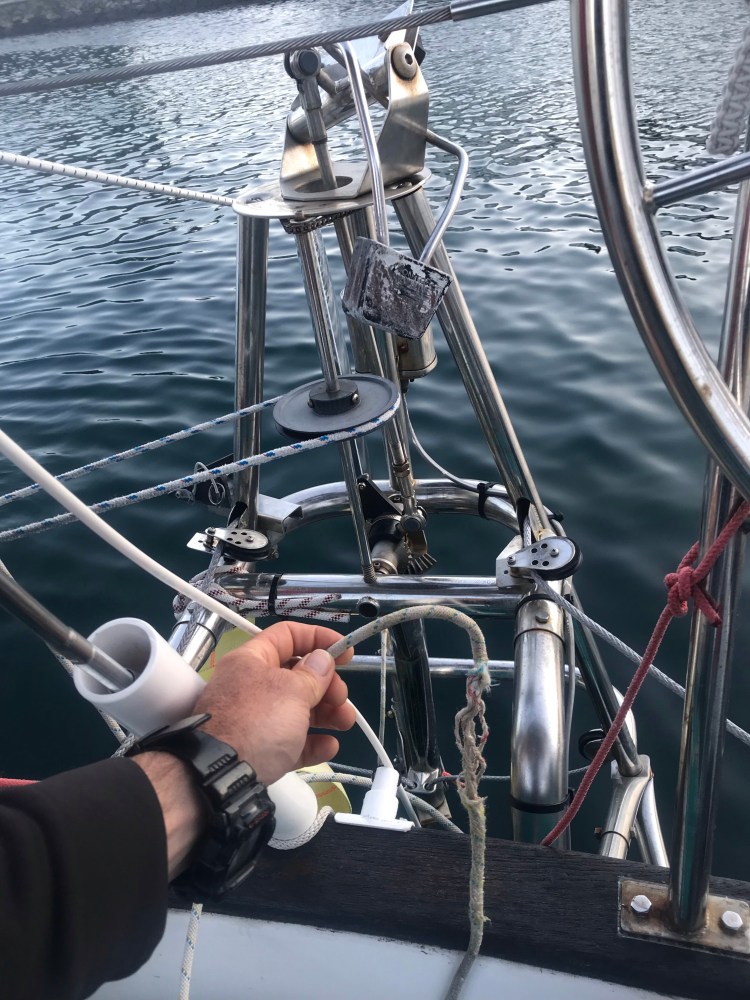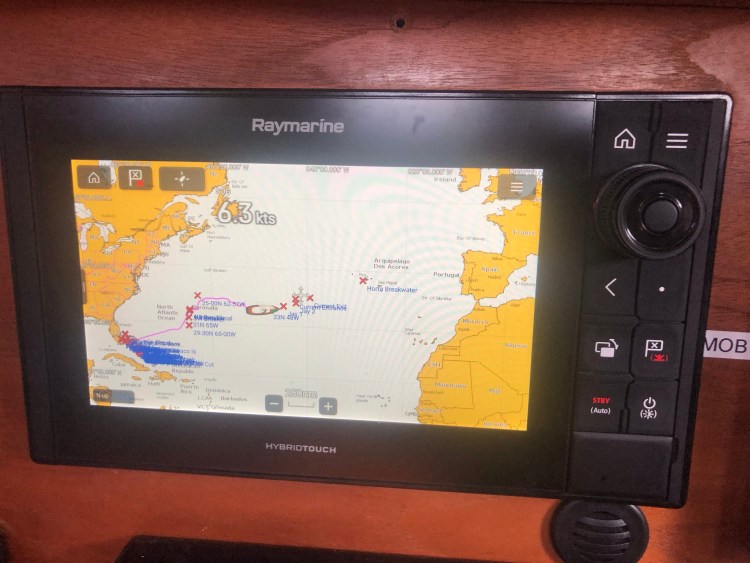I’m a big hockey fan and there’s a pretty good—but not perfect—analogy to my current situation. If a solo crossing of the Atlantic is my Lord Stanley’s Cup, I’m preparing for game five of the best-of-seven series. I’ve got what sportscasters might say is a “comfortable” 3-to-1 lead and I just need to win one more game to hoist the Cup. “Comfortable” per the sportscaster, not so comfortable for the wise coach and team captain.
The rhumb line (straight line on a map) from Ft. Lauderdale to Bermuda was 920 nautical miles (nm, multiply by 1.15 to get land-based miles), and I sailed 1,015 nm to achieve the goal; Bermuda to the Azores (the big one) was 1,800 nm rhumb line and for me was 2,223 nm of sailing. By comparison, from the eastern Azorian harbor of Ponta Delgada on the island of Sao Miguel to Lisbon, Portugal, is 770 nm rhumb line. I’ve taken a few licks here and there so I wouldn’t say that I’m up 3-nil against my “opponent,” but I’ve fared well enough that I’d say a 3-to-1 lead is a good approximation.
The analogy starts to break down when I consider: Who, or what, is my opponent? I’m certainly not doing battle against the sea or against Poseidon, that would be a first-order fool’s errand…end-of-sentence. The analogy further breaks down when I realize that the “games” are not necessarily played sequentially. If a hockey team who is up 3-to-1 in a series has a bad night in Game 5, they can only end the night up 3-to-2. Conversely, a combination of a couple poor decisions by me and gale or storm coming from nowhere, mixed with a little bad luck and I could lose three games in a night and end up the “loser” of the series very quicly. Often when I think of Colleen’s struggles in her later years, I’m reminded of the quote, “Life has to win every day, but death only has to win once.” My situation is a lot different and I wouldn’t call sailing across the Atlantic death-defying, but the comparison is there.
The bottom line lesson for me from the analogy is that I need to keep my head in the game and not take “victory” as a sure thing or for granted, and recognize that I still have a significant sail in my near future. A few years ago, I would have thought of 770 nm of open ocean as incomprehensible. My four rules stand: 0 – Don’t freak out, 1 – Take care of yourself, 2 – Take care of your boat, 3 – Keep the boat moving in the general right direction (the unwritten corollary to these four rules are to not expend energy on anything else when passage making).
With all that being said, here are some pictures from Hazel’s and my passage from Bermuda to the Azores…














It’s interesting with all these miles of sailing that fittings, lines, and other sundries that would last for years of coastal and weekend excursions on Hazel James chafed and wore considerably. Although she was designed, engineered, and built to be a long-distance, blue water (off shore) cruiser, when I first acquired her I probably sailed her every other weekend and maybe for a 15 nm per sail. That would be 390 miles of sailing in a year, and in relatively benign conditions. Given the 3,000+ nm of sailing I’ve done already this voyage, and doing it in whatever wind and seas that Poseidon threw at me, Hazel has seen “ten years” in a matter of months. While, in general, boats like to be used and don’t like to sit idle, I’ve got to be diligent (and keep my head in the game) when walking the decks and looking for wear and chafe, and addressing the situation proactively.


On the open ocean, I’m only actively and directly steering the boat about 1% of the time. For the rest, she’s steering herself. Her main long-distance steering mechanisms use the power of the water rushing past her to control lines that are attached to her steering wheel. There’s a good video of this that I did several years ago here. Those lines took a lot of chafe on the passage.

There’s an analogy in here to the emotional wear and tear on me over the days and days of sailing. A happy diversion was to think about the subject of my nightly satellite post (and thank you all for reading!). Thanks all to Rhett and close friends who sent me well-meaning and supportive messages that I totally misinterpreted during some of my low points.
Since arriving in the Azores on Wednesday, June 15 I’ve been in the Horta marina on the island of Faial. While I had grand plans to visit most all of the other nine islands of the Azores and climb the volcano Pico Alto on the neighboring island of Pico, the weather has conspired against those plans. While it’s disorientating to say so, I would liken the weather over the last week to springtime in a high-altitude US Rocky Mountain ski town. It’s bizarre to say that it feels “alpine” at sea level. The temperature has been in the 60s (obviously Fahrenheit) with patches of sun. However, as soon as I get excited about the sun, dark clouds and misting rain is driven through by the relentless and strong northeast wind. Locals assure me that this weather is unusual but we’ll have to see on that. I tend to believe them because—in addition to being locals—the prevailing wind that we should be experiencing (and what I need to get me to Lisbon) is from the southwest.
In addition to cleaning up Hazel and boat projects, I’ve been doing a lot of hiking and touring of local museums on Faial with Welsh and Dutch friends I originally met in Bermuda. Spending days with friends from other countries is so enlightening. I’m happy to say that at the age of 57, I think I am finally understanding the nuances between the geography, political organizations, and countries of the British Isles. I find myself repeating back to my always-patient friends what they have said to make sure my understanding is reasonably accurate. It makes me want to go back to grade school and high school and pay attention this time in my geography and French classes.
The geography and geology is amazing here as we are at the Azores Triple Junction (the ATJ for those in the know). It’s where three tectonic plates intersect: the North American Plate, the Eurasian Plate, and the African Plate. Thus islands in the middle of the sea and amazing amount of both “recent” and not-so-recent volcanic activity. Many of our hikes have been over and around calderas (large cauldron-like hollows that forms shortly after the emptying of a magma chamber in a volcanic eruption), lava bubbles, and even new land that has risen out of the sea in the last 70 years (a true geologic blink-of-the-eye).







These next couple pictures are from Capelinhos on the western end of Faial. The lighthouse used to be like most lighthouses—on the coast. However a 13-month series of eruptions started in 1957 and left the lighthouse more than a mile from the ocean. Unbelievable. I remember from school days that geology and geography seemed so old. Like nothing ever happened. Not so when you are where three tectonic plates meet.


This morning Hazel and I plan to “lace up the skates” and depart on a 150 nm sail east-southeast from Horta on the island of Faial, past the island of Pico to Ponta Delgada on the eastern Azores island of Sao Miguel. Given Hazel can make 120-130 nm in a good 24 hour sail, I’m hoping to arrive in daylight.

In Ponta Delgada, I’ll enjoy Sao Miguel, rest, provision, and wait for a good weather window to embark on my 7-10 day sail to the Lisbon area and mainland Europe.
It’s interesting, and in retrospect not surprising, that while my sail from South Florida to Bermuda was a bit lonely, my longer sail from Bermuda to the Azores was quite “social.” Bermuda is a focal point in the western Atlantic where many sailing yachts from the Caribbean, US, and Canada layover before pushing on the long sail east. Also, St. George’s Harbour in Bermuda is relatively small, promoting a feeling of kinship. Fellow sailors in dinghies motoring or rowing past Hazel were constantly stopping to talk. In addition all of boats in the focal-point of Bermuda had a common destination: the Azores, and we departed in “clumps” coincident with good weather. Through high frequency radio and satellite email, a group of five boats that departed with Hazel all stayed in touch throughout the crossing and I had instant friends in Horta.
I’m afraid that this last leg may be a bit lonely as well. Boats departing the Azores are all headed to different destinations in Europe, the Mediterranean, and other Atlantic Islands. In Ponta Delgada, I’ll be asking around with other boats to see if I can connect with others who are headed to Lisbon or other ports nearby on the Portuguese and Northwest Spanish coast.

Rhett and Dachshund Sunny have plane tickets to arrive in Lisbon on July 12 and I really want to be there to meet them when they arrive. However, in the spirit of keeping my head in the game, and in this 3-games-to-1 “lead” that I have, I’m going to be careful to wait for “the right” weather window to embark (or, better said, a “good enough” window). While the weather window will never be totally perfect, in the excitement of the prospect of rejoining with loved ones, it’s important to not look at the weather charts, squint your eyes, and pretend to see what you want to see and sail off into immediately dangerous conditions.
In my sail, I think it will be important to conserve energy (and sleep) early in the sail. When I approach mainland Europe I anticipate encountering a lot of both big ship traffic and small (often not well marked) fishing vessels. I’ll need to be alert on those last couple nights of the sail.
Wish me luck when the puck drops. Hazel James out.

Glad you are safe Thank you for the blog
T
I am so glad that Doc Leavers turned me on to your blog to follow this adventure… I check every day for an update. Thank you for sharing this adventure with others. I hope to visit the Azores at some point. Ancestors of mine came to America from Pico Island and were successful whalers and fishermen. Good luck on the next leg. I’ll be reading! Frank “Scoli” Johnson, SKN Fall 1987.
Amazing read, Dan! Glad you are safe. Thanks for sharing 🙂
Go Avs!
Wishing you all the best on your passage to hoist Lord Stanley’s Cup. We will be watching..cheers…S&D
Great update. Stay safe & Bring back the cup, Dan! Thinking about you (&colleen) last weekend. We were all in telluride for the festival.
Dano my brother. The chafe of the passage….give Hazel’s gunwales a pat for me.
Enjoy the journey, my friend. Stay safe.
What a great experience and display of fortitude and focus.
Have a great sail to Horta! Be careful and heed the rules :).
Dan,
Sounds like you’re staying safe, and I hope the last leg of your massive journey turns out to be the inspiring spiritual experience you need to continue to heal. Praying for a safe journey for you, and all those who plan to meet in Europe.
Steve
So beautiful there, I also like to see all of the gear run into the ground, nice to see things get properly used.